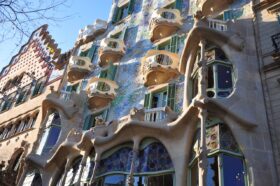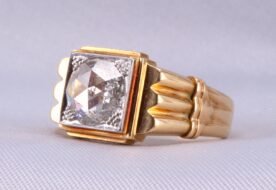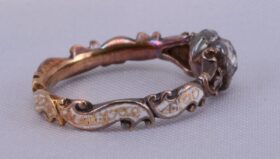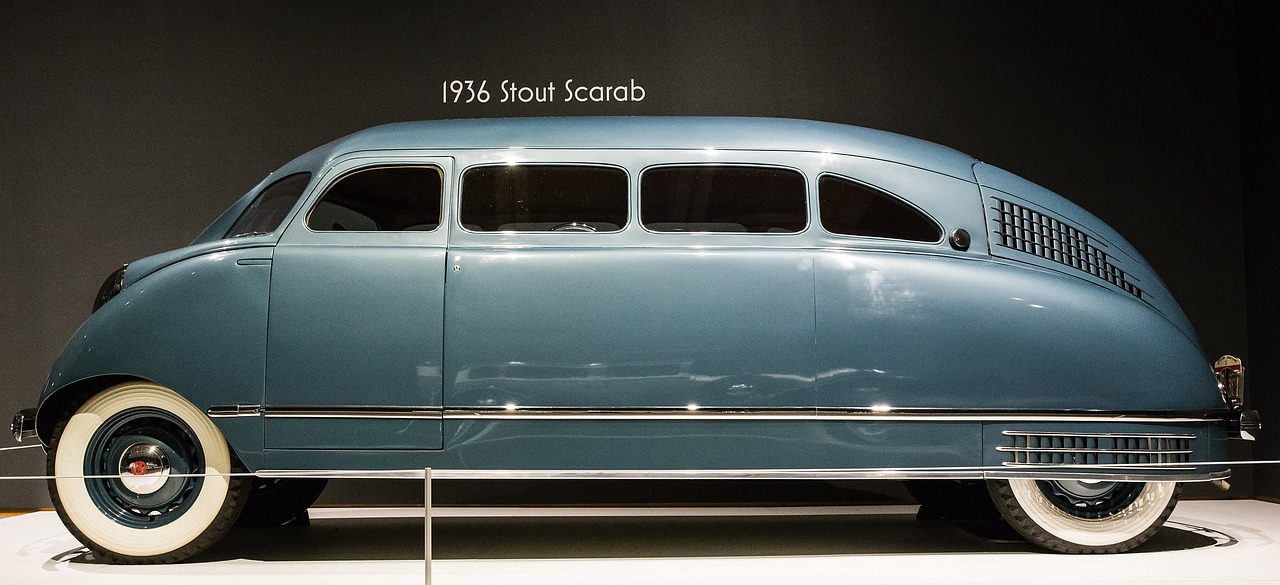
31 Mar Jewelry Designers of the Art Deco Period
Seen Above: A 1936 Stout Scarab Automobile from the Art Deco Era
At C. Blackburn Jewelers, we have a passion for the entire Art Deco period, from architecture and cars to fine jewelry and mechanical timepieces. The Art Deco period is a design movement that emerged in the 1920s and 1930s, and is characterized by its use of bold geometric shapes, bright colors, and perfect symmetry.
In architecture, Art Deco buildings were characterized by their sleek, streamlined designs, often featuring zigzag and chevron patterns, sunburst motifs, and intricate reliefs. Some of the most famous Art Deco buildings include the Chrysler Building and the Empire State Building in New York City.
In the automobile industry, Art Deco design was characterized by the use of aerodynamic curves, chrome accents, and luxurious materials such as leather and exotic woods. Some of the most iconic Art Deco cars include the 1938 Bugatti Type 57SC Atlantic and the 1936 Stout Scarab.
Fine jewelry and watch designs of the Art Deco period were characterized by their use of geometric shapes (such as triangles, rectangles, and circles), colorful precious gems, and new gemstones such as black onyx and jade. Platinum was a popular metal, as well as white gold and silver.
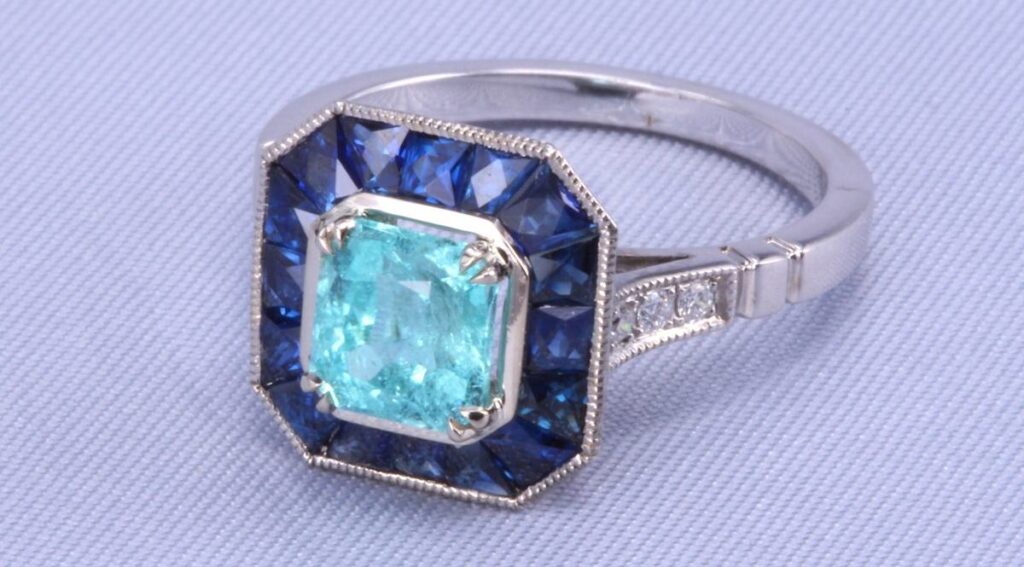
Famous Art Deco Jewelry Designers
Art Deco jewelry became a popular trend beginning in the 1920s, thanks to jewelry design houses such Cartier, Van Cleef & Arpels, and Tiffany & Co., all of whom helped popularize the bold new geometric trend in fine jewelry. A few of the most respected Art Deco jewelry designers, whose jewelry remains highly sought-after today, are as follows.
Raymond Yard
Raymond Yard (1898-1964) was an American jeweler and designer who played a significant role in the Art Deco jewelry movement. He began his career in the early 20th century as a salesman at the prestigious jewelry house of Marcus & Co. in New York City. There, he quickly developed an eye for design and a deep knowledge of gemstones, metals, and craftsmanship.
In 1922, Yard was promoted to head of the company’s newly established department of fine jewelry, where he worked closely with the firm’s president, George Marcus, to create some of the most iconic Art Deco pieces of the era. Yard’s designs were known for their impeccable craftsmanship, use of platinum and diamonds, and intricate details, such as filigree work and micro-pavé settings.
In 1929, Yard left Marcus & Co. to establish his own jewelry firm, Raymond C. Yard Inc., which quickly became known for its exceptional quality and design. His clients included some of the most prominent names of the era, including members of the Vanderbilt and Rockefeller families, as well as Hollywood celebrities such as Joan Crawford and Claudette Colbert.
Louis Cartier
Louis Cartier (1875-1942) was the grandson of the founder of Cartier, the legendary luxury jewelry and watch company that was established in Paris in 1847. Louis Cartier took over the family business in 1899 and quickly established himself as a leading figure in the jewelry industry.
In the early 20th century, Louis Cartier became enamored with the Art Deco style, which was then emerging as a major design movement in France. He began incorporating the style into his jewelry designs, creating pieces that were characterized by bold geometric shapes, bright colors, and lavish ornamentation.
One of Louis Cartier’s most significant contributions to Art Deco jewelry was his use of platinum. Prior to Cartier, jewelry was typically made from gold, but Cartier recognized the unique properties of platinum, which is both stronger and more malleable than gold. He began using the metal extensively in his designs, creating pieces that were both more durable and more intricate than anything that had come before.

Georges Fouquet
Georges Fouquet (1862-1957) was a French jeweler and designer who played a significant role in the development of both Art Nouveau and Art Deco jewelry. As the Art Deco style emerged in the 1920s, Fouquet adapted his celebrated Art Nouveau style to incorporate the bold geometric shapes and bright colors that were characteristic of the movement. He continued to use innovative materials, but began incorporating diamonds and other precious gemstones (such as emerald and black onyx) into his designs.
Fouquet played a key role in promoting the work of other Art Deco designers. He was a member of the Société des Artistes Décorateurs and helped organize the 1925 Exposition Internationale des Arts Décoratifs et Industriels Modernes in Paris, which was a major showcase for Art Deco design. Through his work as a jeweler and his role as a promoter of the movement, Georges Fouquet helped shape the course of Art Deco jewelry and design.
Louis Comfort Tiffany
Louis Comfort Tiffany (1848-1933) was an American artist and designer. He was the son of Charles Lewis Tiffany, the founder of the famous American jewelry company Tiffany & Co. In the late 19th century, Louis Comfort Tiffany began experimenting with glass as a medium for decorative arts, eventually founding the Tiffany Glass Company in 1885. He quickly became known for his innovative use of color and pattern in his glasswork, creating pieces that were both beautiful and functional.
In the early 20th century, Tiffany began expanding his design work to other mediums, including jewelry. He incorporated many of the same design elements that characterized his glasswork, such as vivid colors, intricate patterns, and natural motifs, into his jewelry designs. He was a member of the Society of American Artists, and his work was exhibited at major international exhibitions, which helped American jewelry designers make inroads into markets previously dominated by European jewelry designers.
Tiffany’s influence on Art Deco jewelry was significant, particularly in the United States. His designs were known for their exceptional craftsmanship and attention to detail, and he was particularly known for his use of enameling, which he incorporated into many of his pieces.
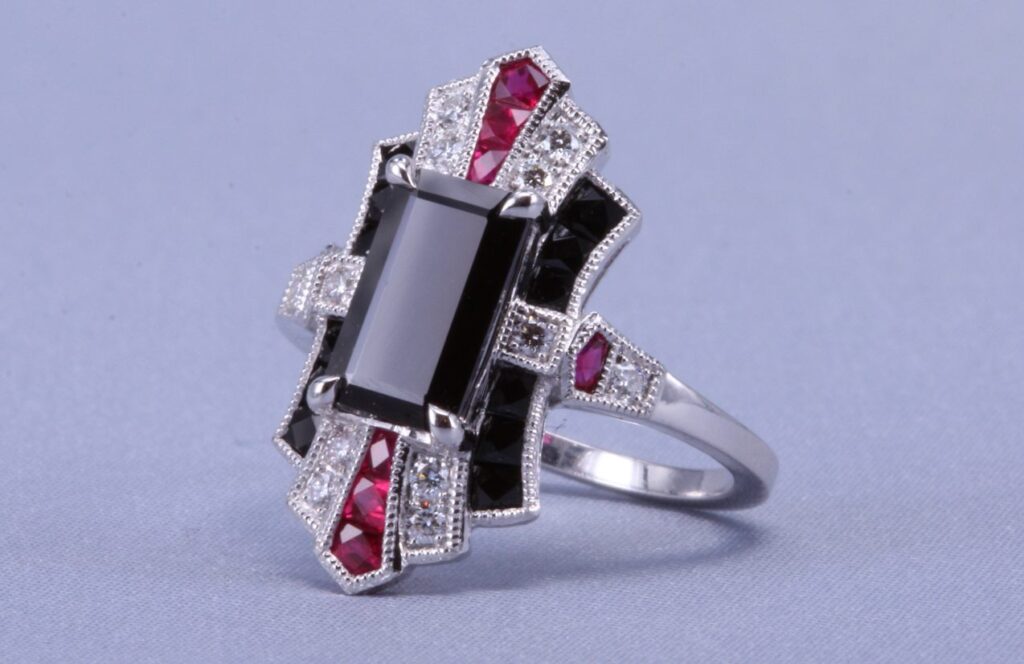
Suzanne Belperron
Suzanne Belperron (1900-1983) was a French jewelry designer known for her bold, modernist designs that broke with traditional jewelry-making techniques. Her designs were characterized by their innovative use of materials, such as rock crystal, lacquer, and chalcedony, as well as her bold use of color. She also pioneered new techniques in jewelry-making, such as the use of a gold alloy called “vermeil,” which allowed her to create pieces that were lighter and more flexible than traditional gold jewelry.
One of Belperron’s most notable contributions to jewelry design was her use of the “cabochon” cut, in which a gemstone is cut with a smooth, rounded surface rather than the traditional faceted surface. This technique allowed Belperron to create jewelry with a unique, sculptural quality that was unlike anything that had come before.
Belperron’s designs were highly influential during the Art Deco and Art Moderne periods, and she counted many notable artists and cultural figures among her clients. Despite her success, however, Belperron’s work was largely overlooked by the traditional jewelry industry, in part because she refused to sign her pieces, preferring instead to let her designs speak for themselves.
In recent years, however, there has been renewed interest in Belperron’s work, and her designs continue to be highly sought after by collectors and connoisseurs around the world.
Raymond Templier
Raymond Templier (1891-1968) was a French jewelry designer whose designs were characterized by their clean lines, geometric shapes, and use of negative space. His Art Deco jewelry often incorporated industrial materials such as steel, aluminum, and chrome, which gave his pieces a modern, minimalist look.
Templier was also known for his use of engraving and other decorative techniques to add texture and interest to his pieces. He was particularly skilled at creating complex, layered designs that combined different materials and textures.
One of Templier’s most notable contributions to jewelry design was his use of the “tank track” motif, a repeating pattern of intersecting lines that was inspired by the treads of military tanks. This motif became one of his signature design elements and was widely imitated by other designers during the Art Deco period.
Templier’s designs were highly influential during the 1920s and 1930s, and he counted many notable artists and cultural figures among his clients. In addition to his work as a jeweler, Templier was also an accomplished illustrator and writer, and he published several books on jewelry design and decorative arts. His innovative use of materials and geometric forms continue to influence contemporary jewelry designers around the world.
Art Deco Inspired Jewelry
If you would like San Diego jewelry designer Carl Blackburn to create for you a gorgeous piece of Art Deco inspired jewelry, please contact us today. Call 858-251-3006 or send us a message below. Our boutique jewelry store in La Jolla Cove is easy to reach from cities throughout San Diego County. We can also help you buy authentic Art Deco jewelry made during this vintage era.

